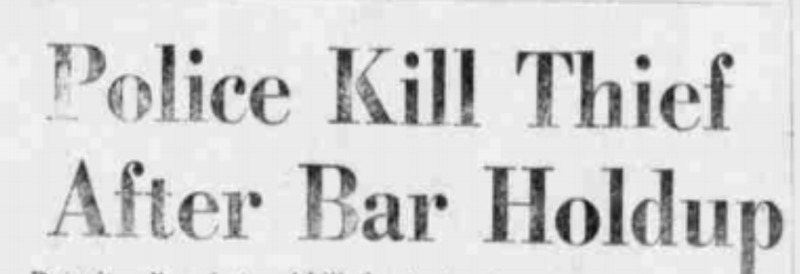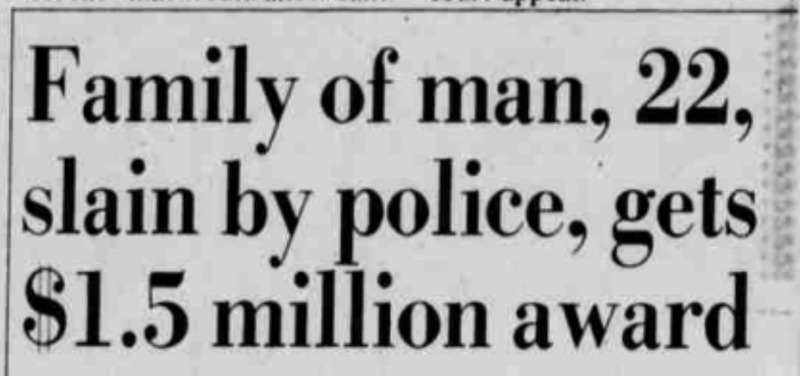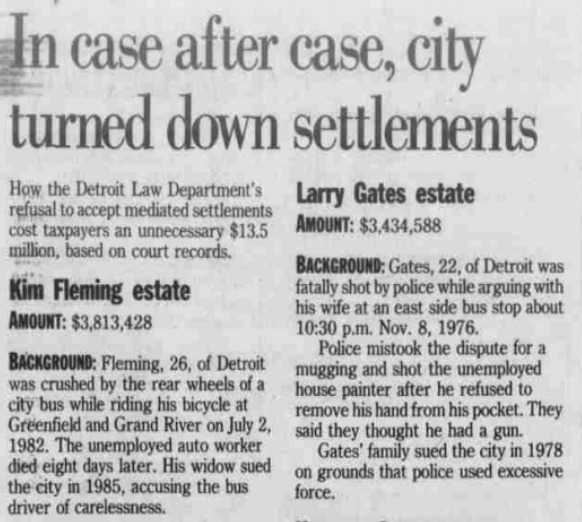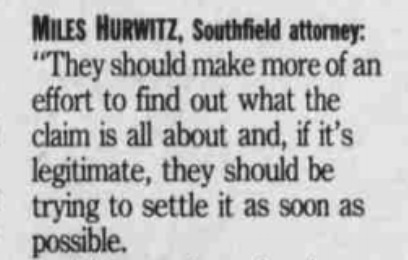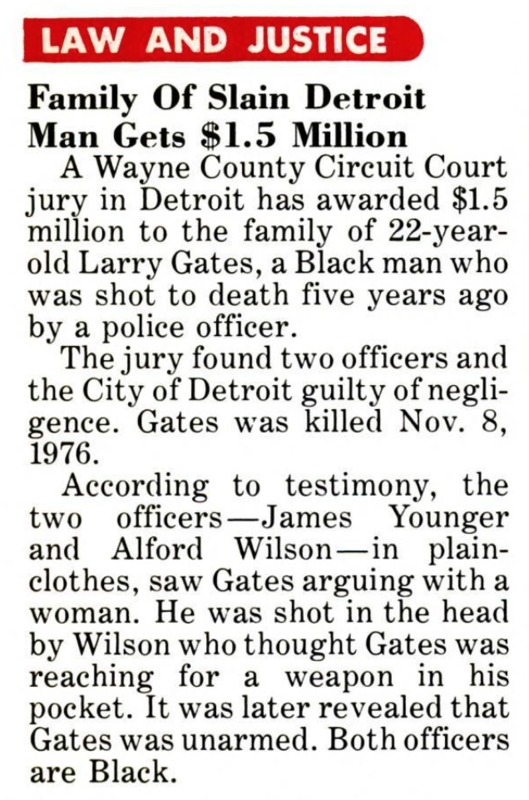Homicides
It is first important to restate where our information on the homicides comes from and take the space to acknowledge the inherent holes in our findings. Our metadata is sourced primarily from citizens’ complaints (especially pertinent in 1974), newspaper articles ( The Detroit Free Press, The Detroit News, and The Michigan Chronicle) and when available, civil suits. In each year there were hundreds more complaints generated than we can access. Furthermore, our primary newspaper resources, The Detroit Free Press and The Detroit News had a close relationship with the DPD. As such, it was unlikely any article would be overtly critical of the officer’s perspective or behavior. This bias is especially evident in the Jesse McKinney case. The officer completely fabricated his narrative and yet the newspaper published a short paragraph on the incident, entirely absent of doubt. The paper was also selective in which stories would get published. The absence of data is particularly evident in the areas with the lowest income.
As far as the patterns we noticed across the homicides, the most prevalent involved an officer’s attempt to create a narrative of self defense. The officers were aware that a self defense claim would result in reduced punishment, especially if it could be substantiated with the presence of a weapon. One of the most common claims involved a nonspecific, common object such as the razor in the Larry Winstead Case, or a knife. Once nicknamed “Mr. STRESS” for the amount of civilian homicides he committed, Raymond Peterson admitted to frequently employing the tactic. He said he used to plant knives at the crime scene and attribute them to his victim. Once STRESS was abolished, the pattern continued, as outlined in the Jesse McKinney case. It is rare to have such a detailed investigation on the misconduct, but one can reasonably assume that this was not an isolated incident of paying homage to Mr. Peterson. Several other homicides also mention knives or other random objects that were more likely instances of a frantic officer attempting to alleviate their punishment than a legitimate threat by a civilian.
As we attempt to evince patterns and underlying causes of police violence and misconduct, it is important to consider the relationship between the egregious actions of individual officers and the explicit policy governing their behavior. By closely examining the use of force policies we can illuminate the ways that officers were emboldened to abuse their power. When addressing police use of force in the abstract the DPDs policy in the 1970s was quite strict. The preamble to the 1977 policy on the rules and regulations regarding the use of firearms states “the laws of this state and the rules of the department demand that members use only the minimum degree of force necessary to effect an arrest.” The policy goes on to specify that the amount of force should be commensurate to the severity of the crime that a suspect has committed. The department explicitly tells officers to “consider that the maximum sentence imposed by our court system would result in neither death nor injury” before deciding whether or not to shoot someone. The DPD policy even quotes the Michigan Police Manual to impress upon them that “neither law nor morality can tolerate the use of needless violence, even upon the worst criminals.” These broad statements make it sound as if the department wants to take a strong stance against excessive force and is seeking to reduce police homicides at all costs, but they fail to back up these claims with clear, specific guidelines. During this time period the use of firearms was not explicitly limited to cases where officer or civilian lives were in danger. Officers were allowed to shoot someone who was fleeing as long as they were a felon. They were not even barred from shooting fleeing juvenile felons. It was merely discouraged. The lack of comprehensive, and explicit policy limiting police use of force in specific situations gave officers more discretion, which led to further abuses of power. The DPDs leaders failed to limit the number of decisions officers on the ground had to make about whether or not to use lethal force. In an organization rife with bias and outright vitriolic racism this policy failure unequivocally led to police killing civilians who could have been protected.
To properly understand the nature of police violence it is important to go beyond the enumerated policies and specific cases to the department’s de facto practices and the culture that existed at the time. While the nominal use of force policy was certainly problematic it does not explain the vast disparity between the enormous volume of citizen complaints and the minuscule number of officers who were actually found to have acted in bad faith—not to mention the fewer still who were disciplined. The first hand accounts of African-American officers in the DPD like David Robinson and Ike Mckinnon—who later became chief—tell of a ubiquitous mindset among officers of callous indifference towards civilian lives. Moreover, officers were discouraged from trying to hold each other accountable through intimidation by their peers and in many cases were blatantly ignored by their superiors when they tried to speak up.
David Arthur Field - January 19, 1974
David Arthur (20) was shot by Officer James Palm (DPD 4th Precinct) and Ross Arena (DPD 4th Precinct) when Field was allegedly attempting to run over the officers. Initially, the officers claimed they stopped Field for a faulty muffler, but the story then changed to speeding away from light. According to the officers, they chased Field and Field’s car went out of control and he crashed into a sign, forcing him to a stop on the curb. As the officers approached, Field allegedly put his vehicle in reverse, heading towards Officer Arena. Arena then fired two shots and Palm fired three. Field was shot in the temple and killed around 3 am in Detroit General Hospital. Mr. and Mrs. Fields filed a suit and created a memorial Fund in their son’s honor.
Evelyn Neal- August 18, 1974
Evelyn Neal (50) was shot and killed by Officer Larry Carter. Ealier in the evening, Neal was with Hubert Heddon and Rosetta Austin when an altercation turned into an alleged robbery. Heddon had allegedly renneged on paying Neal (possibly for a sex act), and she and Austin were demanding he pay as promised. Police were called by the manger of a drug store. Officers Carter and Lloyd Jones responded to the call and claimed Austin had a knife and arrested her. The officers then claimed they saw a small knife under Neal's waistband and demanded her to drop it in attempts to arrest her. Witnesses accounts of the incident differed from police records. Police claimed Neal was attacking Officer Jones, while some witnesses claim she was walking away into a crowd. Carter shot one time at Neal's back, killing her. Evelyn's borther, George Neal, filed a complaint and claimed that witnesses told him Officer Carter had previous interactions with Evelyn and threatened to kill her. Mr. Neal also claimed Evelyn's appartment was ransacked by the police. Officer Carter was not charged for Ms. Neal's death but found in violation of the DPP's amunition policy by the Board of Police Commissioners.
Jesse McKinney - September 12, 1974
Jesse McKinney (24) was shot in the back of the head and killed by Officer James Anderson after allegedly slashing at Anderson with a knife. He was 24, married and had one child at the time of his death. He previously worked for the Chrysler Corporation. There was a lawsuit following the incident that was not settled until 1979, and McKinney’s family received $90,000.
The incident occurred around 9:30 pm on September 12, 1974. The officers were responding to an attempted burglary call from a nearby home and McKinney was the alleged burglary suspect. Office Anderson and Officer Richard Cameron were in uniform, in a marked scout car approaching the address when Sally Sluck, the caller, stopped the officers and informed them that a man had been seen “climbing the steps to the back porch of 5525 Moran in a crouched position as though attempting to sneak into the rear door. Officer Anderson proceeded on foot and saw nothing except for the door slightly open. There were no signs of a break-in according to the civil action case. According to the transcript, an individual “lunged out from the darkness” and slashed at the officer with an object and had his shirt grabbed by McKinney. McKinney then ran and Officer Anderson ordered McKinney to stop. According to Anderson, when the order was ignored, he fired one shot, which hit McKinney in the back of the head and killed him. Allegedly, a knife fell out of McKinney’s pocket and Anderson found it near McKinney’s body and Anderson pocketed the knife.
However, there were three witnesses in the vicinity residing at the residence in question. They were all within the house at the time of the incident, one was even by the rear door where the alleged break-in occurred. None of the witnesses recount any attempt at breaking in and none heard Officer Anderson’s order to “halt.” There were another three witnesses on the porch of the adjacent house at the time of the incident. None heard a break-in, but they did hear running footsteps followed by a gunshot. They saw McKinney on the ground, but they did not see Officer Anderson pick up any object off the ground near the body, nor did they hear any “halt” order.
Furthermore, according to the crime lab inspector for the DPD, Mary Jarrett, the “slashing” of Officer Anderson’s shirt was fabricated. According to her investigation, the cut could not have been made with a slashing motion, but rather even force, and furthermore, it was cut from the inside. From this evidence, it seems most probable the cut was fabricated by Officer Anderson after realizing he had killed McKinney. She was unable to tie the knife with McKinney at all.
It should be noted, the information in the Detroit Free Press is sparse and the incident is not mentioned in the Detroit News or elsewhere in the archive from what has been processed. While this is not explicitly stated in the newspapers or the case file, it seems as though McKinney was just entering his residence when a racist neighbor accused him of breaking in. He was living apart from his wife at the time, after being laid off by Chrysler, and was likely residing with a friend.
Larry Winstead - October 24, 1974
Larry Winstead (21) was shot and killed by DPD Officer Lindsay Joker after Winstead allegedly came at him with a razor in the parking lot of Biff’s Restaurant (Michigan and Wyoming). Joker was previously charged with excessive force but was allowed to remain employed. Joker has allegedly threatened Winstead in the past though the context of the threat is contested by friends of Joker. Had Joker been suspended in his prior case, he would not have been allowed to have the revolver on him that he did at the time of Winstead's death. Winstead's family sued Joker for $12 million. Joker was removed from the force. (For more on Larry Winstead visit this page on Lindsay Joker)
Edwin B Robinson - October 25, 1974
Edwin B Robinson (49) was shot and killed by Two plainclothes officers, William Morgan (31) and Robert Morris (32) after an attempted robbery of Dexter Van Wiklin, 54. Before police arrived, 9 shots were exchanged but nobody was harmed.
Michael O'Neal - November 20, 1974
Michael O'Neal (18) was shot and killed by Off-duty police Officer Michael Trompak (25) after O'Neal attempted to escape with Trompak's car. According to the Detroit News, Officer Trompak awoke to see his car being pulled out onto Lahser road. Trompak grabbed his revolver and ran outside, calling after the driver that he was an officer and demanding the man to stop. Trompak fired a shot at O'Neal which forced O'Neal to pull away. O'Neal continued so Trompak took his wife's car and began chasing O'Neal. O'Neal attempted to turn around on a lawn and Trompak got out of his wife's car and began to pursue O'Neal on foot. Officer Trompak felt that O'Neal was trying to run him over so he fired several shots at O'Neal, ultimately killing him.
Larry Gates - November 8, 1976
Police Sgt. Alford Wilson shot and killed an unarmed African-American man named Larry Gates, 22. According to the police account Wilson and the patrolmen he was with noticed a couple arguing in the street. When the confrontation became physical they approached them and ordered the man, Gates, to freeze. They alleged that Gates then stuck his hand in the pocket of his coat. They insist he then refused to remove his hand from the coat when they ordered him to do so and instead raised his hand while it was still in his pocket. Wilson then fired one shot killing Gates.
Gates’s family filed a civil suit against the city of Detroit for negligence. The officers, Alford Wilson and James Younger, were both found to be culpable of negligence and his estate was awarded $1.5 million in damages.
The city sought to appeal the case and got a new trial. However the appeal was unsuccessful and The City of Detroit Law Department recommended the City Council actually pay the family $3.3 million, which the City Council accepted.
In a big piece synthesizing horrific cases of police killing citizens the Detroit Free Press the big takeaway is that this is a financial crisis, not a humanitarian one. The city's decision to incessantly appeal cases where their officers were clearly culpable of wrongdoing was a financial disaster. However, the implication of the piece seems to be that the answer to this problem is for the city to accept the initial settlement they are ordered to pay not for the police department to try to eliminate unjustified killings of civilians.

